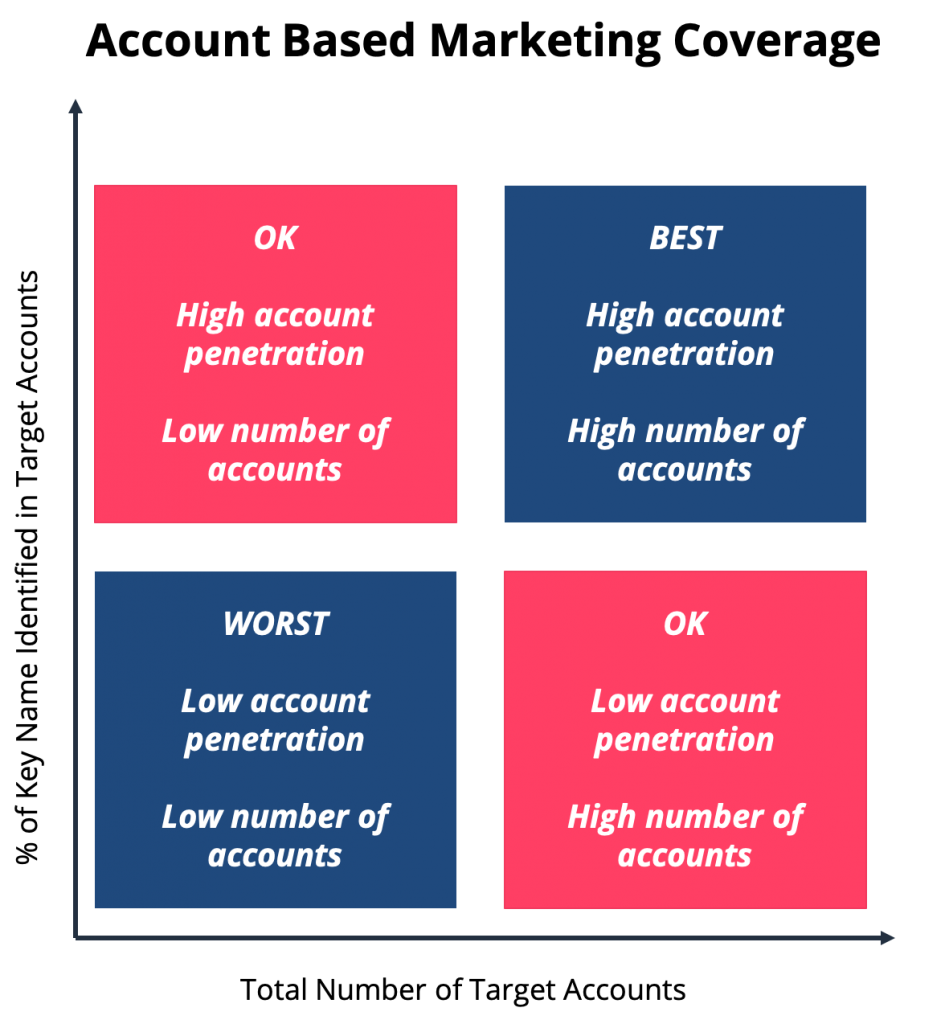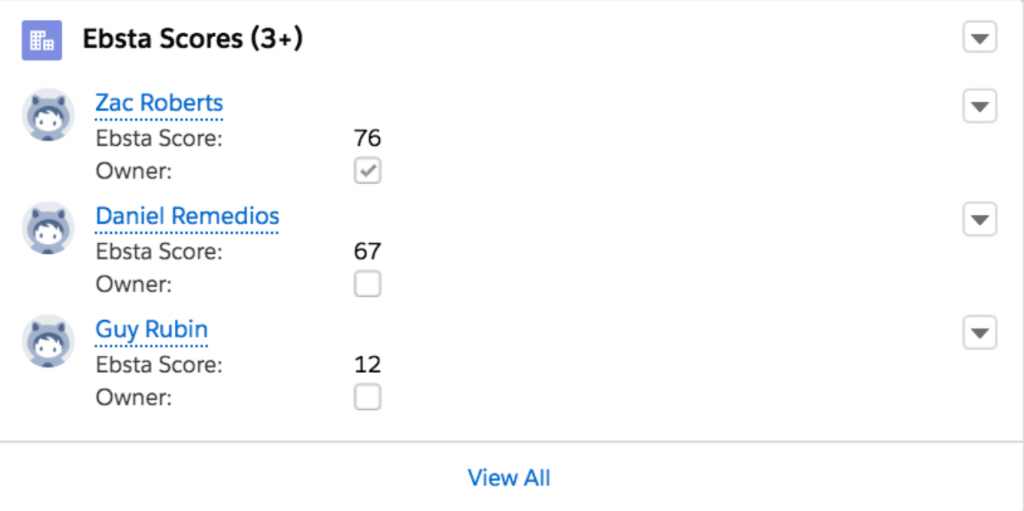Table of Contents
Share this article
Learn from the brightest minds how to predictably and efficiently grow revenue.
Related Content
5 Ways to Use the Ebsta Integration With HubSpot to Improve Sales Performance
How to improve adoption of HubSpot with Ebsta
B2B Sales Benchmarks: 2023 H1 Update
The latest update from the 2023 B2B Sales Benchmarks analysis of over $37bn in pipeline.
How to improve AE quota attainment (according to data)
23% of reps are contributing 83% of revenue. Here's how to solve it (with data)

Account Based Selling: B2B Sales Strategy
Account-based selling isn’t a new concept– but it’s recently exploded as a common practice in sales and marketing circles. Although many predicted the account-based framework would be nothing more than a short-lived trend, it’s actually proven to be a highly effective sales strategy. In fact, 86% of sales and marketing professionals have begun using targeted account strategies to generate new business for their companies.
Table of Contents
What is Account Based Selling?
Account-Based Sales Development (ABSD) is a strategic prospecting process that involves selling to targeted and highly valued accounts rather than focusing your prospecting efforts at the contact level.
Using ABSD, one or multiple sales development representatives are prospecting into a specific number of pre-qualified accounts simultaneously, using multiple channels and targeting multiple decision makers to account for these shifts in the decision-making process.
Account Based Sales Development Best Practices
1) Prioritize Sales and Marketing Alignment
The foundation of any effective account-based sales or marketing strategy is alignment between the sales and marketing teams. Without a coordinated effort between the two, your account-based sales strategy is doomed.
The good news is, an account-based methodology inherently facilitates better sales and marketing alignment. It forces the two teams to work together, rather than against each other. If you’re struggling to get both departments on board, try some of these tips:
- Plan: Develop a shared plan that maps leads to prospects and prospects to revenue—and stick to it.
- Define: Agree upon the definition of a Marketing Qualified Lead (MQL) and a Sales Qualified Lead (SQL)—and hold both teams accountable.
- Analyze: Take a full funnel view of conversion rates and costs to truly understand where leads come from and how they convert.
- Connect: Hold a weekly meeting between sales and marketing leadership with a set agenda.
- Question: Constantly challenge assumptions and improve the customer acquisition and retention processes.
2) Build Your Ideal Customer Profile
An Ideal Customer Profile—or an ICP—is made up of firmographic and behavioral characteristics that define your most valuable customers. Creating an ICP allows you to develop measurable strategies to attract and convert top buyers.
An ICP can inform your entire business strategy from content creation to sales outreach by answering critical questions about the people who need your products—questions such as:
- What are your best customers’ buying motivations and triggers?
- Where and how do your best customers prefer to be engaged?
- What type of messaging resonates with your best customers?
To create an ICP, use a combination of qualitative and quantitative analysis. A good place to start is with data points such as company revenue, number of employees, industry, location, or common job titles. If you find you need more information to work off, dig a little deeper and look at metrics like lifetime customer value, referrals, product usage, customer advocacy, brand prominence, and more.
The goal is to analyze your best customers and find common threads between them—and ultimately, engage accounts who also have these characteristics.
3) Identify Your Target Accounts
The next, and arguably most important, step is to identify your target accounts. There are two key considerations that come into play here—account coverage and account quality.
Let’s start with account coverage. This phrase refers to your team’s ability to identify and penetrate a large number of key accounts. Here’s why account coverage is a vital component to any account-based selling strategy: If you have many target accounts but low levels of account penetration, you’ll have a difficult time converting those accounts into customers. On the flip side, if you have only a few target accounts with optimal account penetration, you’ll only ever be able to close a few deals. This image illustrates what we mean:

Concept adapted from Bizible
To understand and measure account coverage, use these two metrics:
- Percentage of accounts you’ve engaged within your target market.
- Percentage of key personnel you’ve engaged with from within each of your target accounts.
Up next is account quality. Use the Ideal Customer Profile you developed in step two and identify companies that match those key characteristics. We recommend you score each account, just as you would an individual lead.
Here’s an example: If your ideal customers generate X amount of revenue, have X amount of employees, work in X industry, and don’t currently have a product like yours, they receive a score of ‘100’. For every marker they miss, they go down ten points.
This score will help your team prioritize accounts and follow up with them accordingly. Remember, you can have perfect account coverage, but if your account targeting strategy is off, you’ll never generate revenue with your account-based selling strategy.
Companies who have the most success strike the perfect balance between account coverage and account quality.
This is where the Ebsta Score comes into play. We’ve developed the Ebsta Score to help Sales Managers quickly understand their Rep engagement with prospects and customers in real-time.
The Ebsta Score is:
• A score between 0-100 that indicates the level of your engagement
• Generated from analysis of interactions with customers or prospects in real-time. It includes emails, calls and meeting insights
• Weightings are applied to the volume, timeline and type of activity
• Each Rep can be assigned a unique Score based on their engagement
• Engagement is measured between each Rep and each Salesforce Object (whether it be a Lead, Contact, Account, Opportunity or Custom Object). This allows you to immediately identify the strongest relationships and whether the right person is engaged with the record

4) Develop a content and outreach strategy that speaks to your target accounts.
Here’s the part of the account-based selling process where your sales and marketing teams must really be in sync. Remember, the goal of account-based selling is to treat each company like a market of one. Not only do you have to speak to each company’s specific needs, but you also need to speak to each contact’s specific needs as well. This includes each contact’s stage of the buyer’s journey, their specific job responsibilities, and any other concerns they may have.
Content development typically falls in the hands of marketing, but, as a sales rep, you know your accounts and customers best. Therefore, it’s your job to communicate with your marketing team about the types of content they need to create and also provide feedback when you think something looks off.
If you’re interested in the content portion of account-based marketing, here’s a helpful article: 7 Pieces of Marketing Collateral to Include in Your Sales Process.
5) Measure, Test, and Optimize
We’ll let you in on a little secret—the key to successful account-based selling lies in your data and analytics. Think about it: You need customer and prospect data to form your ICP, you need analytics regarding your content and outreach strategy, and you also need performance metrics to determine how successful your efforts are.
Account-based selling is truly a data-driven sales strategy. Each and every decision you make can—and should—be backed by data. That way, you can run tests and optimize your campaigns to generate the best results. Here are a few key metrics to track, some of which have already been mentioned in this article:
- Percentage of key contacts you’ve engaged from each target account.
- Percentage of accounts you’ve engaged from within your target market.
- Account quality score.
- Opportunities and revenue generated.
- Account engagement.
- Improvement over time.
As with any other strategy, you might not be successful the first time around—and that’s okay! Collect your success metrics, make some changes, and try again. The key is to hone in on what works for each account, and scale your success to similar businesses.
What are the Benefits of Account Based Selling?
If ABS fits you, there are several advantages you can look forward to:
Find New Business Opportunities
Account based selling’s highly targeted marketing strategies are best suited for finding right-fit target companies, as well as qualified point persons within these companies. These strategies include medium effort marketing, such as webinars and customized reports, and high-effort marketing, such as company workshops, demos and trials.
Improve Email Response Rates
When you know who you’re talking to, you are in a better position to personalize your communication with them. Email open rates, for instance, are observed to improve dramatically by as much as 60% when ABS is employed. Reply rates also improve by almost 50%.
Increase Revenue
Because the focus is on enterprises that are likely to purchase, deals are often big and efforts pay off within shorter sales cycles. This can potentially mean increased revenue from larger deals and more efficient use of available resources.
According to a survey conducted by Demandbase, 60% of companies that use account based selling for at least a year experienced an increase in revenue.
Increase Deal Size
Your CRM system’s features can be put to great use in determining a company’s fit as an ABS target. Note their purchase history, firmographics, and buyer behavior, among other metrics. These metrics help you zoom in on qualified targets, and draft deals that suit their size and requirements.
Maximize Use of Resources Within Shorter Sales Cycles
A study by ITSMA, a B2B services marketing company, found that 80% of marketers believe that account based selling outperforms other marketing investments. This is often attributed to the approach’s highly targeted methodologies. When your coordinated efforts are on a target that is likely to buy, then you can look forward to a win – as long as your efforts are data-driven and well-planned.
How Can it Support Your Sales Team?
Ebsta automatically identifies relationships across your whole business – whether they’re in a different team, department or office.
When approaching an account, you’re able to immediately recognise who has the strongest relationship and leverage their relationship for the warmest possible introduction.
As the prospect progresses through the sales process, the overlap becomes easier, from business development, to sales engineering, to the sales manager, to the customer success manager, helping to improve the customer experience but also promote collaboration between colleagues.

If you’re interested in finding out more, request a demo to get a walkthrough of how Ebsta can help your business better understand engagement.
